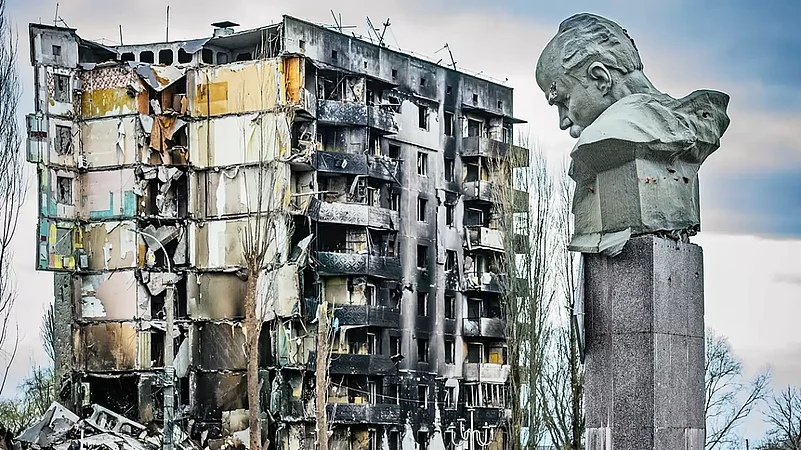The figure of Taras Shevchenko is at the heart of our culture. In the centre of Kyiv stands Taras Shevchenko Kyiv National University, where I work. One of the main buildings of this premier university is located on Shevchenko Boulevard. In front of the university stands a Shevchenko Park, in the centre of which his monument is located. To the left of the university is the Taras Shevchenko National Museum, where his artistic heritage is preserved.
It was on this cultural complex that, on October 10, 2021, the Russians launched two missile strikes as I was heading to work. A missile struck one of the streets directly in front of my office, killing people whose cars were hit and shattering most windows in my institute. The intent was not only to destroy our civilian infrastructure, such as power stations or water supply stations, but also objects of our cultural heritage. Ukrainians defend not only our territory but also our language, national identity, the right to decide our geopolitical future, and the moral right to have our own cultural genius.
There is no truer cultural genius in Ukraine than Shevchenko (1814–1861). Ukrainian poet, artist, ethnographer, thinker, activist of the national movement, and, in modern terms, a dissident. He is the most important figure in Ukrainian culture, a certain measure of the Ukrainian spirit, and in the artistic sense, a towering canonical literary figure, whom many generations of Ukrainian writers emulated and still emulate. For more than a century and a half, no other figure in Ukraine has had such an influence on the literary, cultural and nation-building processes.
To talk about Shevchenko’s biography is also to talk about the history of Ukraine. This is the path from the glory of the free Cossacks, from whose family his grandfather came, to the enslavement/serfdom, which he himself experienced. And it is the path from slavery to freedom. He was sentenced to 10 years in exile, without the right to write or paint, for his ‘excessive’ love for Ukraine and the writing of ‘unhopeful’ texts that undermined the authority of the policies of the Tsar of the Russian Empire. There is something in Shevchenko’s poems that inspires, does not allow Ukraine to ‘sleep’ as a nation, something that reflects the spirit of Ukraine, the eternal thirst for freedom.
Shevchenko is the one who taught Ukrainians to love and protect their identity,
Love your dear Ukraine, adore her,
Love her . . . in fierce times of evil
In the last dread hour of struggle,
Fervently beseech God for her.
(‘Shall we ever meet again...,’ 1947, cycle ‘In the Casemate’. Translated by Vira Rich)
Shevchenko’s words are firm and, without excessive sentimentality, they engrave moral instructions for posterity,
Oh bury me, then rise ye up
And break your heavy chains
And water with your tyrants’ blood
The freedom you have gained.
And in the great new family,
The family of the free,
With softly spoken, kindly word,
Pray, men, remember me.
(T. Shevchenko, ‘Testament’, 1845; Translated by John Weir)
This is exactly what the Ukrainians are doing now, defending their country with weapons in their hands.
We live in an exciting and painful period of the confirmation of conscious independence. And the image of Shevchenko accompanies each of its historical turns, each generation of Ukrainians who defend their land from the Russian Empire, whether the totalitarianism of the USSR or the aggression of modern Russia.
As far as I can remember, not a single rally, not a single action in Kyiv has been held without Shevchenko’s poems. 2014 was the year of the Maidan and the Revolution of Dignity, as well as the 200th anniversary of the birth of the great poet. His image and words were everywhere: on banners, on the protective helmets of the participants of the revolution, on home-made, wooden shields, on their lips. One of the memorable episodes is that of Serhii Nihoian,, a young fighter of Maidan Self-Defence, a Ukrainian of Armenian descent, who reads an excerpt from the poem ‘Caucasus on youtube,
And glory to you, dark-blue mountains,
Frost and snow protect you;
And to you, greathearted heroes,
God does not forget you.
Battle on – and win your battle!
God Himself will aid you,
Ay your side fight truth and glory,
Rights and holy freedom.
(T. Shevchenko, ‘Caucasus’, 1845; Translation by Vira Rich)
Holy Freedom. This is deeply inscribed in our identity. This is what Shevchenko fought for. This is what Nihoian fought for. This is what we are fighting for. Nihoian was killed on January 22, 2014, a few days after this video recording. His death was the first on the Maidan, and, from that moment, the Maidan turned from a peaceful confrontation into a liberation struggle.
Another painful marker is the monument to Shevchenko in Borodyanka near Kyiv, which was shot at close range by the Russians during the occupation.
Undoubtedly, after the victory, the city will be rebuilt and cultural objects will be restored. However, some mutilated shrines, like this monument, in my opinion, should be left as they are. As an eternal reminder to every generation of the price to pay for the right to be Ukrainian.
(This appeared in the print edition as "The Universal Ukranian Hero")
(Views expressed are personal)
Bohdana Sakhno is Director of the Ukrainian Scientific and Educational Centre of Taras Shevchenko Studies, Taras Shevchenko National University, Kyiv

















